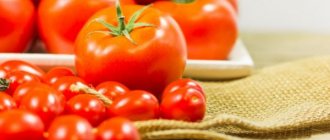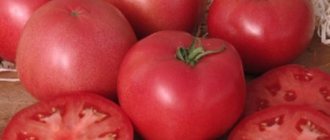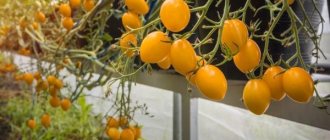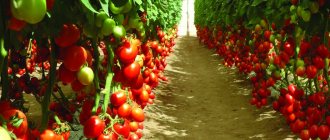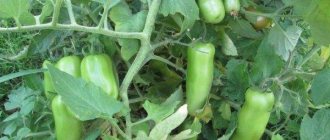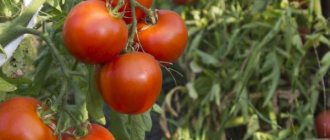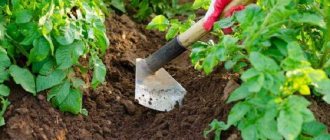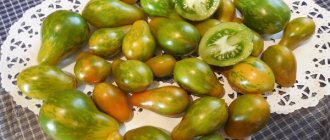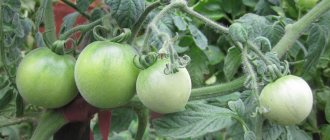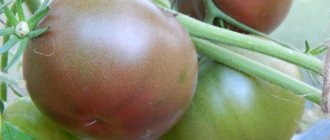Tomato Tender Misha
An early-ripening, low-growing, productive tomato hybrid from Aelita. Recommended for growing in greenhouses, open ground, and film shelters. The period from germination to the beginning of ripening is 90-95 days.
The plant is of a determinate type, well leafy, 60-90 cm high. Requires tying to a support and partial pinching. In general, you can form a plant only up to the first flower cluster.
This tomato has a regular type of leaf.
Fruit characteristics
The fruits are round, dense, smooth, shiny, 3-chambered, red in color at maturity, weighing 150-170 grams, juicy, good (for a hybrid) taste. Not prone to cracking, the skin is very durable. Transportable. These tomatoes are suitable for early fresh salads and processing into tomato products.
Advantages of the hybrid: resistance to blossom end rot and other major tomato diseases, high yield. The fruits retain commercial quality for up to 1.5 months after harvest.
Disadvantages: the taste is inferior to varietal ones.
Features of cultivation, planting and care
We recommend sowing seeds for seedlings 55-60 days before the intended planting in the ground. Seedlings dive at the stage of two true leaves. When planting seedlings in a permanent place per 1 sq. It is recommended to place 4-5 plants per meter of prepared area.
Further care for tomatoes consists of timely watering, partial pinching, fertilizing with complex fertilizers and preventive measures to protect plants from diseases and pests.
Tomatoes Tender Misha on video
If you grew Tender Misha tomatoes, please write whether you liked them or not. What was the yield and taste of the fruits like under your climatic conditions? Briefly describe the advantages and disadvantages of this hybrid. Will you grow it again? If possible, attach a photo of your tomatoes to your comment. Thank you!
Your reviews of the Tender Misha tomato and additions to the description will help many gardeners evaluate this hybrid more objectively and decide whether it is worth planting or not.
Affectionate Misha - variety of tomato plant
Information on the admission of Tomato Laskovy Misha from the Register of the State Variety Commission of the Russian Federation
Application for admission No. 46279, registered 2006-12-01. The Tomato variety Laskovy Misha was included in the register of those approved in 2008. Approved for use in regions: All regions.
The originator of the Tomato variety Tender Misha is:
LLC `AGROFIRMA AELITA` (129343, MOSCOW, NANSEN TRADE, 1)
Information about the patent for the Tomato variety Laskovy Misha
Patent holder of the variety Tender Misha:
LLC `AGROFIRMA AELITA` (129343, MOSCOW, NANSEN TRADE, 1)
Application for protection of the variety Laskovy Misha No. 46836, registered 2006-12-01.
Patent No. 4006, registered 2008-05-20. Estimated patent expiration date 2038-12-31.
- Kachainik Vladimir Georgievich
- Chernaya Victoria Viktorovna
Other varieties of tomato plant
Add new comment
Register or Login so you don't have to enter your Name and Email every time
Thanks for the comment! It will be published after checking by a moderator!
No comments yet, be the first!
A portal for those who love their dacha
Thanks for your question!
Your question has been sent for moderation. Don't worry, we quickly check your questions and your question will be answered within 1 day.
We have noticed that you are already registered on our website. We recommend that you log in to view the created question.
If you don't remember your password, you can recover it.
You were not registered until today, so we have registered you. Your password has been sent to your specified mailbox.
Help our site develop!
Please read this message, it will not take up much of your time!
We so need your comments and questions to understand in which direction we should develop.
Don't forget to leave a comment if you found what you were looking for. And if you haven’t found it, use the “Ask an Expert” form in the site header. We will answer this question, and other visitors will be able to find the information that you could not find.
Thanks for your question!
Your question has been sent for moderation. Don't worry, we quickly check your questions and your question will be answered within 1 day.
We have noticed that you are already registered on our website. We recommend that you log in to view the created question.
If you don't remember your password, you can recover it.
You were not registered until today, so we have registered you. Your password has been sent to your specified mailbox.
Growing tomatoes
To grow the tomato variety “Mashenka” you only need to follow the standard rules of agricultural technology.
How to prepare seeds?
Basic recommendations for preparing seed material:
- Only high-quality seeds are selected for sowing. To do this, they are placed in a saline solution for 20-30 minutes. Seeds that appear on the surface must be discarded as they are unusable;
- The remaining seeds are soaked in a weak solution of potassium permanganate, then washed in clean water and dried;
- Immediately before sowing, a growth stimulant is applied to increase the germination of seed material.
Sowing seed material
Instructions for properly sowing seeds for seedlings:
- Seed material is sown two months before the planned planting in a permanent place;
- To grow seedlings, use common or individual containers;
- All-purpose tomato soil is needed, which is spilled with a manganese solution for disinfection before sowing;
- The seeds are buried 1.5-2 cm into the soil, sprinkled with a small layer of soil on top and moistened with a spray bottle;
- The containers are left in a warm room, observing the temperature regime - from +20 to +22 ºС during the daytime and from +18 to +20 ºС at night;
- Water and feed the plantings as needed;
- After the formation of one or two true leaves, the seedlings are planted in separate pots;
- For 7-10 days before the intended planting, the seedlings are hardened off by taking them outside and gradually increasing the time spent in the open air.
Rules for planting seedlings
How to plant seedlings:
- Planting of seedlings in a permanent place begins in late May or early June;
- It is preferable to grow tomatoes in light, highly fertile soils. It is advisable to use beds after cucumbers, cabbage, legumes, onions, carrots;
- The soil is first dug up and the required amount of fertilizer is applied;
- The width between the rows is 70 cm, the interval between planted tomato bushes should be from 30 to 40 cm;
- During planting, add a tablespoon of a mixture of superphosphate and potassium sulfate to each planting hole.
Features of cultivation, planting and care
We recommend sowing seeds for seedlings 55-60 days before the intended planting in the ground. Seedlings dive at the stage of two true leaves. When planting seedlings in a permanent place per 1 sq. It is recommended to place 4-5 plants per meter of prepared area.
Further care for tomatoes consists of timely watering, partial pinching, fertilizing with complex fertilizers and preventive measures to protect plants from diseases and pests.
Outdoor care
The key to a good harvest of “Mishka Kosolapy” tomatoes is regular feeding. Otherwise, the variety is not very whimsical.
Watering
Tomatoes love moisture very much, so they need to be watered regularly and abundantly (up to 1 liter per bush). It is best to perform the procedure in the evening, after sunset. Water should be poured, settled, at room temperature, and preferably at the root.
Feeding
To form large fruits under the “Bears of the Clubfoot” bush, fertilizer should be applied every 2 weeks throughout the entire period of growth and fruiting. It is recommended to use mineral and organic fertilizers. They need to be alternated. It is undesirable to use manure, since it causes foliage to actively grow, not fruits.
Find out how to get rid of caterpillars on tomatoes.
Stepsoning
Form a bush “Teddy Bear” with 1 or 2 stems. The best harvest is produced by bushes formed from 2 stems. To do this, you need to remove all the stepsons above the 2nd brush. Shoots longer than 5 cm are cut off. In order for the stem to develop better, you should also pinch its top and remove deformed flowers.
Soil care
In order not to bother with cultivating the soil in the tomato bed. Experienced gardeners recommend mulching it. To do this, use forest litter, straw, sawdust, shavings, humus or compost. Under such material, weeds practically do not grow, the earth does not crack and retains moisture for a long time. In addition, on hot days, mulch helps keep you cool.
Did you know? Tomatoes contain a large amount of serotonin (the hormone of happiness), so they can lift your mood just as well as chocolate. The bright color of the fruit also helps with this.
Hilling of bushes is carried out when white tubercles appear on the stem at the base. This is a signal that the plant is lacking nutrients and is about to strengthen its root system.
Tying up a bush
A feature of indeterminate varieties is long and weak shoots. Therefore, without support, the plant will not be able to support the weight of the fruit. In addition, without tying, the yield decreases. Since this variety is tall, it is better to use a trellis or linear garter method. The bush is tied up as soon as the plant takes root in a new place.
Preventative treatment
The variety was bred to be resistant to most pests and diseases. However, it can be affected by various types of rot (white, gray, root, fruit). To ensure that the disease spoils the crop as little as possible, you need to:
- fluff up the soil after each watering if it is not mulched;
- remove weeds in a timely manner;
- pick off the lower leaves;
- Inspect plants daily for pests and treat them with insecticides if found.
Varieties
There are several varieties of the Mishka Kosolapy tomato variety. They differ from each other in the color of the fruit.
The descriptions of the tastes of these varieties are approximately the same. The difference can only be in the size of the fruit and yield characteristics.
Yellow
Yellow tomato bushes grow up to 2 m. The leaves are rich green, the main stem is dense. Due to its strength, it does not deform from the wind. This variety has a good immune system, which does not allow it to be exposed to pests and viral diseases.
The yellow tomato fruit Mishka Clubfoot reaches a weight of 900 g. The shape of the fruit resembles a heart. The skin is deep yellow. The pulp is dense, with a high juice content.
Up to 20 kg of high-quality fruits are collected from 1 bush.
Orange
The plant is powerful and tall. The average height of the bush is 1.5 m. Plants are formed into 2 stems, so the remaining shoots are removed. The leaves are large, dark green.
Description of the fruit:
- heart-shaped;
- presence of edges on the surface;
- orange skin;
- strong aroma;
- dense pulp with a lot of juice;
- minimum number of seeds.
The yield of the species is 16 kg per plant.
Pink
Bushes of pink tomato Bear Clubfoot grow up to 1.2 m. The leaves are medium in size, light green in color. The main stem is powerful, so the bushes are not deformed. The yield of this variety reaches 20 kg per plant.
The fruits are soft crimson in color and teardrop-shaped. The average weight of a tomato is 600 g. Thanks to its juicy pulp, the variety is ideal for fresh consumption or making juices. The taste is pleasant. The vegetable has a characteristic aroma of tomatoes.
Red
The fruits taste sweet
The peculiarity of the red variety is that it gives a greater yield when grown in protected soil. The plant reaches a height of 2 m. The stem is powerful, dark green in color. The beautiful green leaves are compact, so they do not shade the fruit.
The heart-shaped shape of tomatoes attracts the attention of gardeners. Large red fruits form on the bush, their weight is 0.7-1 kg
The taste is sweet. The acid level is minimal. The tomato aroma is pronounced.
Characteristics and description of the tomato variety Kalinka Malinka
It grows of medium height, up to 1.5 m, so there is no need to tie up the bushes. If the air temperature rises above 30°C, as a rule, the yield of other varieties decreases, but for the Malinka tomato this does not interfere with the formation of ovaries and ripening of fruits.
The fruits are pink, round, slightly flattened, weighing on average 200-250 g. From one sq. m. harvest up to 3 kg. Tomatoes do not have a green spot at the stalk. They are suitable for fresh consumption, pickling, and making juices.
Note! The variety is resistant to various diseases, except late blight. You should not plant tomato bushes next to nightshade crops, they have the same diseases, there is a risk of epidemic
In addition, this increases the risk of Colorado potato beetle infestation. It is also not recommended to plant tomatoes in the old place, since pathogenic bacteria may remain in the soil. It’s better to make a bed in a new place every year
You should not plant tomato bushes next to nightshade crops; they have the same diseases and there is a risk of epidemic. In addition, this increases the risk of Colorado potato beetle infestation. It is also not recommended to plant tomatoes in the old place, since pathogenic bacteria may remain in the soil. It is better to make a bed in a new place every year.
Malinka tomato bush
Recommendations for cultivation
For the variety, the seedling planting method is preferred. Planting of seeds begins in mid-spring. To grow seeds, you will need separate containers with universal soil for the nightshade family. Seedlings require maintaining temperature conditions, organizing lighting and watering. The heat-loving plant grows well at air temperatures of at least 20 degrees and requires at least 16 hours of daylight.
IMPORTANT! Before transplanting, seedlings require hardening. The low-growing plant successfully bears fruit when planted densely, up to 5 tomatoes per square meter of land
Further cultivation comes down to following simple rules of agricultural technology: watering, loosening and fertilizing, removing weeds
The low-growing plant successfully bears fruit when planted densely, up to 5 tomatoes per square meter of land. Further cultivation comes down to following simple rules of agricultural technology: watering, loosening and fertilizing, removing weeds.
Seed preparation
The seeds have a high germination rate - up to 97 - 99%. If a summer resident planted the Affectionate Bear F1 tomato last season and collected the seeds himself, then they do not need to be pre-treated.
Purchased seed material must be disinfected before planting. Place the seeds in a solution prepared from 1 glass of water, two drops of vermicompost, one teaspoon of potassium permanganate for 2 - 3 hours. Rinse and dry at room temperature. The second way is to take the tomato seeds out into the sun and warm them up, then bring them indoors at night. Repeat the procedure 3 times.
Tomato Tender Misha characteristics and description of the variety, how to grow with photos
The plant belongs to the determinate varieties. The bush, as a rule, does not exceed 75 cm. The tomato does not require special care. In order to get the maximum yield, it is enough to strictly follow certain recommendations.
- The plant does not like excessive watering, as this can lead to rotting of the roots. The bushes are watered no more than once a week; drip watering is preferable, without the use of hoses and watering cans.
- Although this plant belongs to the determinate variety, it is advisable to tie it to a vertical support. Tying will help reduce pressure on the stem, which will allow all the plant’s energy to be directed to fruit development. The garter also makes spraying more effective, the plant will receive more light, and the risk of rotting and fungal diseases will be significantly reduced.
- This is a relatively early ripening hybrid. Harvesting takes place 95 days after planting the seedlings in open ground. The fruits have a round, slightly ribbed shape. When ripe they acquire a bright red hue. The tomato has high taste, the flesh is fleshy, of moderate hardness. The fruits have six chambers and a small number of seeds.
The bush is covered with dark green leaves. As a rule, the fruits do not lose all their qualities for two months after harvest. If tomatoes are grown for commercial purposes and will be transported, then the fruits are harvested at a state of technical maturity.
Honey sugar tomato - description and characteristics of the variety
Varieties and varieties of tomatoes
The correctly selected tomato variety for the middle zone largely determines the quantity and quality of the harvest. When buying tomato seeds, there are many factors to consider in the middle zone. Firstly, the variety must correspond to the climatic conditions of the area. Secondly, it is necessary to select tomatoes that are most suitable for growing conditions.
There are little-known varieties and hybrids that have not yet managed to attract increased attention from farmers. But there are also the most popular varieties of tomatoes, the popularity of which allows them to be called folk
Varieties for open ground and greenhouses that have earned the greatest popularity, their brief characteristics and descriptions are given below.
How to prepare seeds
Knowing the characteristics and description of the Tender Misha variety, it is important to provide the crop with proper care. The germination rate of seeds of the Tender Misha variety is almost 100%.
Seeds
Tomato Raspberry Empire: characteristics and description of the variety
Purchased seeds should be disinfected before planting. To prepare the solution, you need to combine 2 drops of vermicompost with 1 teaspoon of potassium permanganate solution in a glass of water. Place the planting material there for 2 hours. After washing the seeds, dry them at room temperature.
You can also spread the seed material in the sun, and after completely warming up at night, take it indoors. This procedure should be carried out 3 times.
Note! To avoid deformation during the picking process, it is recommended to sow the seeds in separate containers.
Planting in peat cups will help enrich the planting material with microelements. You can plant the plant in the soil together with a glass; the root system will not be damaged and will continue to actively develop.
Seedling
Low-growing tomatoes for the south of Russia
They also love “kids” in the southern regions. Tiny tomatoes are compactly placed on the beds, and although they are not as productive, they require a minimum of care.
Popular varieties:
- Tourmaline - bred specifically for cultivation in open ground, unpretentious. The fruits have a glossy, smooth skin, are round, weigh 170-200 grams. Color: bright crimson;
- Watercolor - shows a stable harvest of tomatoes in any season. Forms a large number of plum-shaped fruits, weighing about 50-60 grams. Color – red. The consistency of the contents is dense and juicy. The variety is ideal for pickling, preparing various preparations (such as assorted dishes);
- Bobcat F1 is a drought-resistant hybrid from Holland with high yields. The bushes are strong, solid, up to 70 cm high. Removing the stepsons is not necessary. Fruits with barely visible ribbing, glossy skin, red. The color of tomatoes at ripeness is red. The taste is sweetish with pronounced sourness.
Every summer resident can find a place to plant low-growing tomato varieties on his plot. With proper care and proper agricultural technology, these “crumbs” will delight even novice gardeners with excellent results.
Protection from diseases and pests
The Mashenka variety is resistant to major crop diseases. Agricultural techniques help reduce the risk of diseases: ventilating the greenhouse, rationing watering, weeding. If dark spots or other symptoms are detected, the plantings are treated with Ridomil or Topaz.
Advice! Chemicals are not used if there are 3 weeks or less left before harvesting.
Pests cause significant damage to vegetable crops. The most dangerous for tomatoes are thrips, spider mites, aphids, and mole crickets. Folk remedies help fight insects: infusions of onion and garlic peels, wood ash. Extreme measures are the use of insecticides Iskra or Fufanon.
Tomato yield Mashenka
According to reviews, the Mashenka tomato from Biotechnika bears the largest fruits. Some specimens reach 600 g. From 6 to 12 kg of fruits are removed from the bush. Depending on the planting density, the yield per 1 sq. m reaches 25 kg of tomatoes. Fruiting is positively affected by good lighting, moisture and nutrients.
Description of the tomato variety Novichok
Initially, the Novichok tomato variety, a photo and description of which is given in the article, was intended for commercial production in agricultural enterprises in the southern regions. It was supposed to be grown in open ground. However, it quickly spread throughout the European part of Russia. They know about the variety in the Urals, Siberia and the Far East. The variety bears fruit well both in open ground and in greenhouses and greenhouses.
The agricultural technology of the Novichok tomato is one of the simplest. This is due to the unpretentiousness of the variety, the short stature of the plants, and the formation of a small number of stepsons. Characteristics and reviews of the Novichok tomato say that it is highly resistant to late blight and other fungal diseases. This reduces the number of treatments and makes maintenance easier. However, the variety is heat-loving and prefers well-fertilized soils.
The variety is determinate and is distinguished by small, compact bushes. The height of the Novichok tomato is 60-85 cm. The plant is not a standard species and produces an average number of shoots. They are powerful, gray-green in color. However, during fruiting they need support. The reason for this is the large number of fruits.
The leaves are medium sized, the usual shape for a tomato. Slightly wrinkled, with pronounced veins. The leaf blades of a healthy plant are dark green in color and have a barely noticeable edge on the back side.
The newbie blooms with medium-sized yellow funnel-shaped flowers. Inflorescences are collected in brushes of 4-6 pieces in one brush. The first brush is usually formed above the 6th leaf. Next, the tomato lays the brushes through 1-2 leaves. By the time of fruiting, the entire tomato bush is covered with fruits.
What ripe beginner tomatoes look like
It is generally accepted that the shape of the fruit of the Novichok tomato resembles “cream”. However, they are more likely to have a spindle-shaped or cone-shaped shape, tapering towards the nose. The stalk exhibits slight ribbing.
The tomatoes are small, with an average weight of 75-100 grams. Housewives like to use these tomatoes for canning. They fit easily into a jar. The color of ripe fruits is bright, red, without a greenish spot at the stalk.
Interesting fact!
Currently, it is possible to grow only the Novichok variety of red tomatoes, but also pink ones. Professionals also know the variety N. De Luxe. They were released in 2006.
The variety has good taste. Their tasting score is 4.6 out of 5. It could be higher, but many people don’t like the thick skin. Novichok tomatoes are fleshy, the number of seeds inside the fruit is small. The fruits are sweet, with slight sourness and a bright aroma.
Varieties and varieties of tomatoes
The correctly selected tomato variety for the middle zone largely determines the quantity and quality of the harvest. When buying tomato seeds, there are many factors to consider in the middle zone. Firstly, the variety must correspond to the climatic conditions of the area. Secondly, it is necessary to select tomatoes that are most suitable for growing conditions.
There are little-known varieties and hybrids that have not yet managed to attract increased attention from farmers. But there are also the most popular varieties of tomatoes, the popularity of which allows them to be called folk. Varieties for open ground and greenhouses that have earned the greatest popularity, their brief characteristics and descriptions are given below.
Tomato Intuition F1
Numerous reviews of the Intuition F1 tomato speak of the excellent presentation and productivity of the variety. This hybrid was one of the first bred by Russian breeders. In terms of fruit ripening, it is considered average, since it forms a harvest in 110-115 days from the moment the first leaves of the seedlings emerge. According to the type of growth, Intuition F1 is an indeterminate plant, reaching a height of about two meters.
The fruits have an attractive appearance and are well suited for sale. The vegetables ripen together, their shape and size are almost the same: they weigh about 100 grams each, spherical, not divided into ribs. The pulp is dense, not watery, the peel is thin, but not prone to cracking. Sweet and sour taste, pleasant aroma, smooth, standard fruits are well suited for canning, as well as fresh consumption.
Tomato Koenigsberg
A brief description of the variety and characteristics of the Koenigsberg tomato boils down to the fact that it does not react to sudden temperature changes in the summer, is not susceptible to diseases, and is unpretentious. The Koenigsberg tomato received another positive assessment - the description of the variety as a determinate plant that grows up to two meters and is very fertile. The inconvenience of high growth is more than compensated by the continuous return of a rich harvest.
The Koenigsberg variety is a mid-season variety; the growing season lasts 110-115 days. As already mentioned, the yield is high - 5-20 kg/sq.m. The shape of the fruits is elongated, heart-shaped, pointed downward. Color – bright red. One vegetable weighs from 300 to 800 grams, which makes it possible to classify the variety as large-fruited.
If for some reason it is not possible to grow everyone’s favorite variety, Koenigsberg, it can be replaced with varieties similar to it in certain characteristics.
In terms of ease of care, the Valentina tomato tends to match this variety. The first thing that usually begins with the characteristics of the Valentina tomato is that the plant does not require special growing conditions, so it is suitable even for the most inexperienced amateur gardeners.
In terms of large-fruitedness, the Eternal Call tomato variety is not inferior to the Koenigsberg variety, which forms truly gigantic fruits, weighing from 500 to 900 grams, and the total yield is about 4 kg/sq.m.
The Azure Giant F1 tomato, which produces flat-rounded fruits weighing from 200 to 700 grams for salad purposes, can boast of increased yield rates of giant tomatoes.
Tomato Verlioka F1
Another Russian hybrid that has earned the respect of summer residents is Verlioka F1. All thanks to the fruits of classic shape, size and taste. The variety’s commitment to traditional standards is also confirmed by reviews of the Verlioka F1 tomato left by grateful farmers on the forums.
Garden Internet pages provide all the necessary information for those who want to grow Verlioka tomato - a description of the variety and its characteristics. The variety is a hybrid, early ripening, intended for cultivation in greenhouse shelters and open beds. The plant is not very tall, it is classified as determinant, and does not grow above 1.5 meters.
The first harvest is harvested on the hundredth day after mass germination of seedlings. Productivity indicators are good - up to five kilograms per bush. The branches form clusters on which three to five tomatoes ripen. The fruit is medium-sized, with a smooth surface, round, slightly flattened. The weight of one vegetable is from 70 to 100 grams.
Tomato Gourmand
Reviews about the Lakomka tomato encourage planting, stating that the variety is distinguished by good yield indicators (7 kg/sq.m.), early ripening (85-100 days), tasty and juicy fruits. The variety is determinate, the height of the bush reaches 60 cm, the foliage is average, the plant is not very spreading. The fruits are round, raspberry-red, with a very delicate pulp texture.
Tomato Lazyboka
You can often hear good reviews about the Lezheboka F1 tomato, as a variety with high rates of transportability and long-term storage. Most likely, due to its good keeping quality, the tomato received the name Lezheboka (sometimes the name Lezhebok is found).
The plant is mid-early, the period from the appearance of the first leaves to the formation of edible fruits takes 107-110 days. Designed for greenhouses. The fruits are flat-round, red in color, weighing 150-160 grams, and have wonderful taste. Universal to use. The crust, which is not prone to cracking, is another advantage of the variety, as it makes it possible to use whole tomatoes for canning.
Tolerance to long-term storage is also characteristic of the Stresa variety. This is confirmed by reviews of the Stresa tomato, which indicate excellent transportability and the ability to remain fresh for a long time.
Reviews of the Laskovy Misha F1 tomato on the Internet speak about all the strengths and weaknesses of the variety. The positive qualities of the variety include, first of all, increased immunity to such unpleasant tomato diseases as fusarium, tobacco mosaic and alternaria. Affectionate Misha is also valued for its tolerance to a small amount of light, as well as to adverse weather conditions.
Another pleasant bonus of the variety is good keeping quality. The fruits remain fresh for up to 75 days after being picked from the bush. The disadvantage is that, despite their determinacy and small growth (only 65-75 cm), the bushes require gartering and shaping. The fruits are round in shape, flattened, medium in size (150-170 g), the color of ripe vegetables is red. They can be used both fresh and for canning, freezing and drying.
Tomato Fidelity F1
The Fidelity F1 tomato is popular for its ability to produce a harvest after the first mass harvest of fruits. High-yielding variety – 16-18 kg/sq.m. An early hybrid, the growing season lasts about 100 days. The fruits are round, red, weighing 200 grams each. The taste is excellent and it is universal in use.
Tomato Kish-Mish
The Kish-Mish red tomato is valued for its special productivity, the clusters of which really look like grapes. The indeterminate tomato Kish-Mish grows up to two meters, requires support and garter, as well as the formation of bushes. The plant is mid-early and can be cultivated in a greenhouse and grown “in the open air”. On one bunch there are six ribbed, round-flat red tomatoes, weighing from 200 grams, which leads to a good harvest - 25 kg/sq.m.
Tomato Kish-Mish
Tomato Kievlyanka
Among the well-known and favorite varieties, there is often a description of the Kievlyanka tomato with medium-late ripening periods. A productive variety that produces interesting cube-heart-shaped fruits. The average weight of one tomato is 300-500 grams, but you can grow a larger vegetable - up to 1 kg. The variety is designed for fresh consumption; its juicy and fleshy pulp will decorate any salad.
The taste of tomatoes can be neutral, sour, sweet and sour. But there are varieties in which a large amount of sugars in the pulp makes them sweet like honey. The advantage of such varieties is that they are very useful for children. And the kids themselves are unlikely to give up sugary, practically non-acidic fruits.
Tomato Honey Drop
The most interesting thing that the Honey Drop tomato can boast of is the description of the variety and appearance. This tomato really looks as if a drop of honey just fell from a spoon and turned into a wonderful vegetable. Magic breeders from Russia were able to accomplish such a miraculous transformation. Based on the type of cluster formation with fruits, this variety is classified as a cherry variety.
One bunch contains from 10 to 15 yellow droplet tomatoes, weighing from 10 to 30 grams each. The plant is very tall, growing up to two meters in height, which indicates its determinacy. The advantages of the variety are considered to be the “non-capricious nature” of the crop, the ability to use seeds for planting next year, high yield rates, beautiful appearance of the fruit and a pleasant, very sweet taste and aroma.
The Honey Candy tomato variety is similar to “Honey Drop”. It also forms clusters similar to cherry tomatoes. Its fruits are also yellow, but slightly larger in size (15-30 g). The shape is slightly different: the elongated vegetables resemble amber candies. There are reviews about the Honey Candy tomato, which claim that the taste of the tomatoes is really candy-honey, very sweet.
The plant is determinate, greenhouse, the average height of the bush is 0.7-1 m. Tomatoes are placed on a cluster of 15-26 fruits, and the clusters themselves are 5-6 pieces on one plant. Productivity indicators are about 5 kg/sq.m. The harvest dates are mid-early, the growing season lasts 110-115 days. The plant is resistant to most diseases. With excessive watering, the fruits do not crack.
Care
The variety requires mandatory fertilizer
Tomato Bear Clubfoot needs certain care procedures:
- formation of bushes, pinching shoots. If more than 2 stems have formed on the bushes, they are broken off;
- this variety needs a lot of moisture, so watering is carried out at intervals of 4 days, adding 4 liters of warm water to each bush. The best time for watering is evening. So the sun's rays that fall on the leaves will not cause burns on the plant;
- To ensure that small amounts of moisture remain in the soil (to avoid evaporation), the beds are regularly mulched. To do this, use sawdust, straw, humus or grass. These organic substances can be replaced with black film;
- fertilizing is carried out with complex fertilizers. A week before flowering, fertilize the beds with a solution of ammonium nitrate (100 g per 5 liters of water), which improves the formation of inflorescences. During fruit formation, superphosphate is added (400 g per 10 liters of water). A week before harvesting, pour 5 liters of potassium nitrate solution (300 g per 10 liters of water) under each bush. Avoid fertilizers that contain fresh manure. This substance can stimulate the development of green mass, reducing the quality and quantity of the crop.
Disease Prevention
This variety belongs to crops with a good immune system. The following diseases do not affect him:
- late blight;
- fusarium;
- tobacco mosaic.
Periodically, signs of gray or blossom-end rot appear on the surface of the bushes of the Mishka Kosolapy variety. It is impossible to get rid of these diseases, so preventive spraying is carried out using Bordeaux mixture (300 g per 10 liters of water). Treatment is carried out every 2 weeks.
To avoid the occurrence of diseases and pests, greenhouses are ventilated. In protected and open ground, loosen the soil and remove weeds on which bacteria parasitize. When naked slugs appear, treat the plant with ammonia (1 bottle diluted in 5 liters of water). If you notice wireworms on the bushes, use a solution of Karbofos (100 g per 10 liters of water).
Tomato Mishka clubfoot - productive, large-fruited and very tasty
Variety - “BEAR CLAW-TOED ORANGE”. Tomatoes from Fyodor.
These tomatoes are very productive and tasty.
Agricultural technology of tomato variety Mashenka
Tomatoes of the Mashenka variety are grown through seedlings. Seeds are planted at home. When the seedlings grow up, they are transferred to a permanent place. Care is important for tomatoes throughout the growing season.
Growing seedlings
Mashenka tomato seeds are planted in March. Boxes or plastic containers with holes are prepared for them. It is most convenient to use separate containers or peat tablets. This way you can avoid picking seedlings.
Tomatoes require light, fertile soil. The soil is taken from the site or a ready-made substrate is bought in the store. The soil is poured into containers and the seeds are placed on top. Leave 1.5 cm between them. When planting Mashenka tomatoes in peat cups, place 2 - 3 seeds in each cup. Subsequently, the healthiest seedling is selected. After planting the seeds, a layer of soil or peat no more than 1.5 cm is poured on top. The soil is watered and the containers are covered with polyethylene.
Advice! Tomato sprouts appear faster in the dark at temperatures above 25 °C.
When the seeds germinate, the containers with tomatoes are moved to the windowsill. The seedlings are regularly cared for: watered with warm water, protected from drafts, and provided with lighting 12-14 hours a day.
Picking is carried out when the plants have a 2nd leaf
The tomatoes are carefully removed from the containers and placed in separate cups. When transplanting, choose the most powerful and healthy plants
After picking, water the soil. For the first 5 - 7 days, the temperature in the room is maintained at 16 - 18 ° C.
Landing rules
Tomatoes are ready for transplanting into a greenhouse or outside at the age of 55 - 60 days. The beds for the crop are prepared in the fall. The soil is dug up and fertilized with rotted manure. Tomatoes develop best after root vegetables, cabbage, cucumbers, onions, and herbs. Planting after tomatoes, potatoes, and peppers is not recommended.
Tomatoes require good lighting and fertile soil. In cool climates, seedlings are planted in a greenhouse or greenhouse. In the south, the bushes grow well in the open air.
A cloudy day is chosen for transplantation. Planting holes 30 cm deep are prepared in the garden bed. The plants are removed from the container along with the earthen lump and transferred to a new place. Then the soil is compacted and watered. Planting density – no more than 3 plants per 1 sq. m.
Watering and fertilizing
Mashenka tomatoes tolerate short-term drought. On average, bushes are watered every week. Plants need moisture during the flowering period to set fruit. For 1 sq. m pour up to 5 liters of warm, settled water. When the crop ripens, watering is reduced to 2 - 3 liters so as not to cause cracking of the tomatoes.
After planting in the ground, the tomatoes are fed with slurry. After flowering, fertilizing is applied based on superphosphate and potassium salt. For 10 liters of water, 35 - 40 g of each fertilizer is required.
Universal fertilizer for tomatoes – wood ash. It is applied to the soil or added to water before watering. Feeding is carried out no more than once every 2 - 3 weeks. It is allowed to use ready-made mineral complexes developed specifically for tomatoes.
Pinching and tying
According to its characteristics, the Mashenka tomato belongs to the tall variety. Therefore, plants require pinching. Excess shoots growing from the leaf axil are cut off by hand. The procedure is carried out until the stems reach a length of 5 cm.
For tying, separate supports made of metal or wood are used. You can stretch a rope between them every 30 cm. The tomatoes are tied to the resulting trellis near the stem.
Formation
Bushes of the Mashenka variety are formed into 2 stems. 4 - 5 brushes are left for each stem. With this scheme, the plants bear fruit well, and the tomatoes are illuminated by the sun. When fruiting begins, all the leaves in the lower part of the bush are torn off.
Agricultural technology
Light, fertile soil is suitable for planting tomatoes. You should choose an area where beans, carrots, peas, and onions grew last season. The soil after potatoes is not suitable for planting tomatoes.
A few days before planting, the seedlings gradually begin to harden. Take it out into the open air first for 2 - 3 hours, then gradually increase the time. Leave it on the veranda where direct sunlight does not penetrate. Before planting, feed with fertilizer.
Plants are planted in the greenhouse and under film in mid-May. In open ground, planting is carried out much later, when spring frosts have passed. In the first days after planting, regular watering is necessary. The soil should be constantly slightly moist. Water only with warm water.
While the growing season is ongoing, it is necessary to apply complex fertilizer 2 times. Watering is done as the soil dries out. Excess moisture harms tomatoes. The garden bed needs to be cleared of weeds in a timely manner. Seedlings are planted no more than 6 bushes per square meter.
With proper planting and care, this tomato variety will surprise you with a rich harvest. Despite the fact that the characteristics of tomatoes are positive, it is better to plant tomatoes in a greenhouse or under a film cover.
Tomatoes do not tolerate fog and frost, which in many regions occur as early as September. By following all the rules of agricultural technology, high yields are ensured.
Characteristics of tomato
The copyright holder recommends growing the variety in greenhouses, but according to reviews, the “Rosy Cheeks” tomato is cultivated in the Krasnodar Territory and Crimea in open areas and shows good yield results. Taking into account the mid-season ripening in the southern regions, the tomato is not exposed to low temperatures; it only needs ultraviolet radiation for photosynthesis, so the taste and size of the fruit are not lost.
Productivity and fruiting
The variety belongs to mid-season crops, the interval from planting to ripening is 3 months. The fruits ripen at the same time; in greenhouses, harvesting takes place from early August to the second half of October. In open ground 2 weeks later.
The amount of harvest depends on the conditions in which the variety grew. If the seedlings are planted in a greenhouse, the harvest will be up to 4 kg per unit. Productivity is achieved through indeterminate cultivation of the crop. Use a side shoot to increase the growth of the tomato to the height of the trellis (1.5 m). In open ground, fruiting is lower, the bush is not tall, the fruit harvest is approximately 2.5 kg per unit. Tomatoes in greenhouses with 1 m3 yield within 12 kg, in open ground - 7 kg. According to reviews from summer residents, the “Rosy Cheeks” tomato shown in the photo does not differ in productivity, its advantages: the appearance of the fruit and taste characteristics.
Attention! To prevent ultraviolet deficiency from affecting the tomato vegetation, the greenhouse is opened completely during the day in sunny weather.
Resistance to diseases and pests
The tomato variety “Rosy Cheeks”, grown without film cover, is affected only by late blight among fungal and viral diseases; other infections appear extremely rarely. In conditions of high humidity in greenhouses, tobacco mosaic, brown rot, and powdery mildew may occur. Pests parasitizing the crop: slugs, Colorado potato beetle, whitefly, tomato mite. The variety is not genetically resistant to infections and insects.
Area of application of fruits
The medium-yielding tomato variety “Rosy Cheeks” is unprofitable for cultivation on large farm areas. The costs of agricultural technology are not justified by the amount of fruiting. Tomatoes are grown in the garden for fresh consumption. The fruits are used to make juices and become ingredients for homemade preparations. Tomatoes are large in size, so they are salted in large containers rather than in glass jars.
Advantages and disadvantages of the variety
The advantages of the “Rosy Cheeks” tomato variety include:
- Simultaneous ripening of fruits.
- Large, aesthetically pleasing tomatoes with a bright, unusual color for the crop.
- Good fruit taste.
- Possibility of growing in open ground.
- Average yield, which can be increased by forming a bush.
- Resistance to long-term absence of abundant watering.
The disadvantages of tomato include the unprofitability of cultivation on a production scale. The bush grows greatly and takes up a lot of space. Requires constant removal of stepsons and preventive measures against diseases and pests.
Characteristics of tomatoes variety Thick cheeks
When choosing the best variety of tomatoes, a gardener should focus not only on the yield of individual varieties of nightshades, but also on the difficulty of caring for them. One of the best options for such varieties is the Thick Cheeks tomato.
Characteristics of tomato variety Thick Cheeks
This crop has many advantages in cultivation. From one small bush you can get up to 5 kg of delicious sweet tomatoes.
Characteristics of tomato
Tomato Thick cheeks determinate. It can be grown both in greenhouses and in open ground. The fruits ripen in 103-110 days from the moment of sowing the seeds to harvesting. The characteristics of this variety are surprising. Despite its short stature, the tomato is a high-yielding variety. In addition, it has immunity to diseases and pests.
Description of the tomato bush
Thick cheek tomatoes are easy to grow not only in a greenhouse, but also outside. In addition, the compactness of the bushes (up to 70 cm in height) is combined with the power of the stems, which can support a weight of fruit up to 5 kg. You still can’t do without tying. All necessary supports are installed immediately after planting the seedlings in the ground.
The foliage of this bush is medium-sized, dense, dark green.
For the fruit to fully ripen, it is important to obtain a sunny color, so dense foliage is often pruned, as are the stepsons. Such measures help normalize the distribution of energy by the root system
This way the bush will concentrate its energy on ripening the fruits.
Description of fruits
In a greenhouse, the yield is higher. Domestic gardeners are confident that with proper care it is possible to achieve higher results.
The quality of the tomatoes themselves is no less important. Like most tomatoes, they are red in color. Their weight is small - up to 220 g, and their shape is flat-round. According to the characteristics, the fruits are characterized by the following:
- juicy pulp with a small amount of seeds;
- no tendency to crack the skin;
- good presentation of the fruit;
- good transport tolerance and long-term storage.
Features of cultivation
Seedlings are susceptible to cold
Tomatoes are best grown from seeds, sown in early spring. The process of growing seedlings is simple:
- The seeds are planted in fertile soil. You can buy a ready-made substrate or make it yourself by mixing garden soil with humus.
- After sowing, the pots are covered with polyethylene and put in a warm place.
- When the shoots appear, the film is removed and the containers with the sprouts are placed in a sunny place.
- Picking is carried out with the appearance of the second leaf.
Seedlings are prepared for transplanting outside or into a greenhouse only after warming the ground to 18°C. Any cold snap can destroy young plants, so in the northern regions it is better to plant them in a greenhouse. The seating scheme is dense: per 1 sq. m dig up to 5 bushes.
Tomatoes bear fruit better in areas where zucchini and cauliflower were previously grown. These plants leave behind a large amount of microelements useful for tomatoes.
For better growth, tomatoes need root feeding.
Caring for seedlings also has its own characteristics. It is better to water with warm, settled water. The frequency is determined by the condition of the soil, which should be loosened regularly
It is also important to fertilize. In total, they are carried out no more than 3 times during the season.
It is best to use complex mineral formulations.
Diseases and pests
According to the description, the variety has disease-resistant immunity. He is not afraid of fusarium and verticellosis. If tomatoes are grown in a greenhouse, regular ventilation and moderate watering are important. Excess moisture and excessive soil moisture can cause blossom end and root rot.
The plant also needs preventative treatment. It is best to spray with specialized preparations. You can also use copper-containing compounds.
Brief description of the variety
Russian breeders have not tied the variety to specific regions. “Bear-footed bear” is cultivated in temperate climates, northern latitudes and southern regions. In areas with cold, short summers, growing in a greenhouse is recommended, and in areas where the heat lasts for a long time, in an open garden.
Main characteristics:
- Indeterminate type, tall - reaches 150 cm in height, and greenhouse ones - higher.
- Mid-season “bears” ripen in the open ground in the south and even in the middle zone. Northerners harvest only in protected soil.
- The tops of the “clubfooted bear” are not abundant. There are few leaves, which simplifies care during the formation of the bush.
- Like many large-fruited varieties with heart-shaped tomatoes, the bush requires tying to a trellis and pinching.
- Productivity within the limits specified by breeders is achieved by forming a bush of 1 or 2 stems. For single shoots, all the stepsons are removed, and for a two-stem bush, the lateral stepson that appears under the first brush with flowers from the bottom is left. Each stem has its own garter.
- Carefully following the advice on agricultural technology, gardeners remove plus or minus 5 kg from the bush.
The pulp of the fruit has already been mentioned, but the “bears” taste sweet. Average weight – 500-600. If you control the number of ovaries (leave no more than 2 in the brush), then you can even pick up 800–900 g.
Tomatoes are eaten fresh, cut into summer salads, snacks, borscht, and other dishes. They use tomato juice, which even people with high acidity of gastric juice drink without fear.
There are several varietal varieties of “clubfooted bear”:
- Tomato "Teddy bear orange". The fruits are bright, rich red in color. They emit a characteristic tomato aroma more strongly than others, and if this is what you value vegetables for, then you won’t find a better variety.
- Yellow tomato “Teddy Bear”. The tallest: reaches 190 cm in height. It is not difficult to guess that the fruits have a characteristic yellow color. Pleasant, richly sweet taste of fruits reminiscent of a heart.
- Raspberry or pink “toed bear”. The bush is no higher than 150 cm, so many people choose this species. And people in Russia love pink varieties of tomatoes. Among the “bears” it stands out due to its elongated teardrop shape. These are one of the largest tomatoes.
- “Teddy Bear” is red. A tall plant that feels better in shelter rather than on the ground. They are readily grown and valued for their excellent table taste and great weight.
Characteristics and description of the tomato variety Honey Candy
The Candy tomato is a variety that will appeal to most vegetable growers for its low maintenance requirements, the good taste of ripened fruits and their fairly early ripening.
Tomatoes have long been firmly established in the human diet. They are used fresh, salted, pickled, added to other types of homemade preparations, and prepared as juice. Listing all the dishes that include this vegetable is a long task.
Tomato Honey Candy f1 is one of these improved hybrids. Vegetable growers who want to plant this variety in their garden should know about its positive qualities and much more.
The history of the hybrid
The Konfetka tomato variety is the fruit of selection by Russian scientists, which breeders were breeding at the beginning of this century. Their work was successful, and in 2005 this hybrid was entered into the state register.
And although Honey Candy appeared on the tomato market relatively recently, it is already in great demand among vegetable growers in different regions of our country. It is especially appreciated in large farms that specialize in growing tomatoes for sale.
Main characteristics and description of the hybrid
The description of the variety should begin with the timing of fruit ripening. From the moment the first seedlings appear until the tomatoes fully ripen, it takes about 3.5 months, so this hybrid is classified as a mid-early variety.
In the southern regions and the Volga region, this variety is grown in open ground, but in the middle zone and regions with a similar climate it is better to grow Honey Candy in greenhouse conditions or under film. The bushes of this vegetable belong to the determinate type, so they do not grow in height above 0.9-1.0 m. The shoots are erect, powerful, weakly branched.
Honey Candy f1 can be grown in garden beds; it is also perfect for planting in greenhouses. The hybrid has average resistance to diseases that usually affect tomatoes. Due to the fact that the fruit ripens quite early (in mid-late July), Honey Candy is practically not affected by late blight.
The shoots are slightly leafy, the foliage is large, dark emerald in color. The inflorescences are arranged alternately with the foliage. This hybrid is classified as Cherry, so each cluster usually ripens 15-27 small fruits. In total, no more than 6 brushes are formed on one shoot. It is best to form each bush with no more than 3 stems to achieve better ripening of the crop.
The color of ripe fruits is yellow with an orange tint. Their weight is about 25 grams, the taste of ripe fruits is excellent. The productivity of the Honey Candy tomato is quite high - up to 6 kg per 1 m². Moreover, in greenhouses from this hybrid the amount of harvested crop is higher than in open ground.
Advantages and disadvantages of the variety
The main advantages of the variety include:
- high productivity;
- good external quality of the fruit;
- the possibility of growing at an industrial level for sale;
- ripe tomatoes are not prone to cracking;
- the harvested crop tolerates transportation well over long distances;
- Possibility of growing in open and closed ground.
The main disadvantages of the Honey Candy tomato;
- in the conditions of central Russia, it is possible to grow a hybrid only in a greenhouse;
- the need for mandatory tying of shoots to supports;
- mandatory stepsoning;
- resistance to major diseases is at an average level.
The forum for this tomato variety provides reviews from those vegetable growers who planted this hybrid. Most vegetable growers say that Honey Candy is one of the best determinate varieties. The variety also has good yield and good disease resistance.
